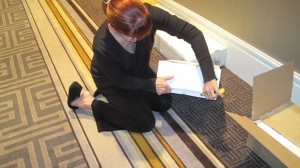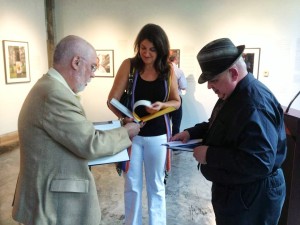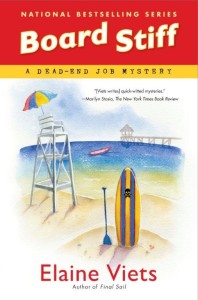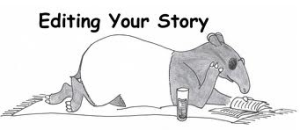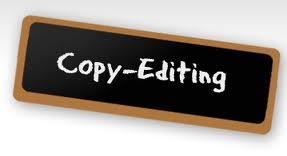Dorothy Parker, the famous wit, once wrote, “This is not a novel to be thrown aside lightly. It should be thrown with great force.” Today’s question, without naming the author or title (unless you simply cannot restrain yourself), what is a book you’ve read that you hated? Did you force yourself to finish it? What was it about the book that made you want to throw it with “great force”?
Monthly Archives: September 2013
A Kill Zone Exclusive – The Show & Tell Book – Guest Photographer William Greiner
I am so happy to have photographer William Greiner as my guest today. I am one of the lucky authors who had an opportunity to contribute to his book – Show & Tell – a beautiful hardbound book that combines his photographs with short stories from authors with names you will recognize. The book comes from UL Press (University of Louisiana at Lafayette Press) and is available now at this LINK.
Below is the page image of the photo I wrote about in my story – On Her Special Day. I wanted you to see the fine quality of this book. I’ve ordered some for Christmas gifts and can’t wait to read what the other authors wrote. Welcome, William!
 |
| Cover – Show & Tell |
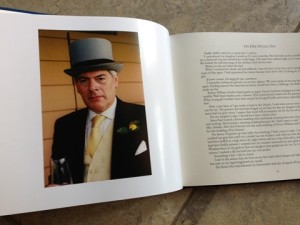 |
| On Her Special Day by Jordan Dane |
So why is a book titled SHOW & TELL being blogged about on The Kill Zone?
First, the premise was to give a group of fiction writers (In this case 28 in total, including 6 TKZ writers), a photograph without any information about the image and ask each to make up a story about that image. The resulting stories are fascinating, entertaining and thrilling.
John Ramsey Miller, John Gilstrap, Joe Moore, Jordan Dane, Joe Hartlaub and James Scott Bell, amongst others, apply their writing skills to bring a story to every image.
 |
| “A Blur of Motion” by John Ramsey Miller |
 |
| “The Touch” by John Gilstrap |
The idea for this book came to me many years ago after doing a print trade with another photographer. In conversation, it somehow became apparent that this other photographer had a complete different take and understanding of my photograph than what it meant to me. It made me realize we all bring our own notions, expectations and experiences to what we view.
To see what your favorite TKZ author sees & tells, order SHOW & TELL from UL Press, hardbound, 28 photographs accompanied by 28 stories, 183 pages, $35. To order: click this LINK.
William Greiner is a photographer and artist, living in Baton Rouge , LA. For more on our guest, click HERE.
For Discussion: Have you ever seen a photograph that inspired you to write about it? Tell us about it.
Suspense vs. Action
By Joe Moore
Back in 1993, country singer Toby Keith had a hit with the song “A Little Less Talk and a Lot More Action”. That was a great hook for a song, but the concept doesn’t always work for thrillers. I’ve found that one of the mistakes beginning writers often make is confusing action with suspense; they assume a thriller must be filled with action to create suspense. They load up their stories with endless gun battles, car chases, and daredevil stunts as the heroes are being chased across town or continents with a relentless batch of baddies hot in pursuit. The result can begin to look like the Perils of Pauline; jumping from one fire to another. What many beginning thriller writers don’t realize is that heavy-handed action usually produces boredom, not thrills.
When there’s too much action, you can wind up with a story that lacks tension and suspense. The reader becomes bored and never really cares about who lives or who wins. If they actually finish the book, it’s probably because they’re trapped on a coast-to-coast flight or inside a vacation hotel room while it’s pouring down rain outside.
Too much action becomes even more apparent in the movies. The James Bond film Quantum Of Solace is an example. The story was so buried in action that by the end, I simply didn’t care. All I wanted to happen was for it to be over. Don’t get me wrong, the action sequences were visually amazing, but special effects and outlandish stunts can only thrill for a short time. They can’t take the place of strong character development, crisp dialogue and clever plotting.
As far as thrillers are concerned, I’ve found that most action scenes just get in the way of the story. What I enjoy is the anticipation of action and danger, and the threat of something that has not happened yet. When it does happen, the action scene becomes the release valve.
I believe that writing an action scene can be fairly easy. What’s difficult is writing a suspenseful story without having to rely on tons of action. Doing so takes skill. Anyone can write a chase sequence or describe a shoot-out. The trick is not to confuse action with suspense. Guns, fast cars and rollercoaster-like chase scenes are fun, but do they really get the reader’s heart pumping. Or is it the lead-up to the chase, the anticipation of the kill, the breathless suspense of knowing that danger is waiting just around the corner? Always try for a little less action and a lot more thrills.
Awards Season: A Survival Guide
So I am doing my usual warm-up before hitting the computer yesterday morning: folding laundry and watching “Frazier” reruns. I love Frazier because beneath his smooth surface is a roiling bog of neediness and insecurity.
Yesterday was the episode where Frazier and his producer Roz are nominated for the Seebee Award, given out to Seattle’s best broadcasters. Frazier tries to be above it all, but he just can’t. He wants to win, dammit! But at the banquet, he finds out he is up against the aging icon Fletcher Grey. Fletcher has been nominated 11 times in a row and lost 10. Fletcher’s date is his 84-year-old mother who has flown in from Scottsdale — for the 11th straight year. Fletcher is also retiring. Frazier tells Roz, “if we win, they’ll string us up.” Roz says, “I don’t care. I’d crawl over his mother to win this award!”
Frazier loses, of course. His agent Beebee deserts him. Roz gets drunk on Pink Ladies.
Sounds like a couple award banquets I’ve been to. A couple I have chaired, in fact. My sister Kelly and I are the chairs of the Edgar Banquet. (That’s me in the photo above unpacking Edgar programs in the Grand Hyatt ballroom. I also do windows). We’ve been doing this chairman gig for about five years now. It’s a lot of work and a lot of fun. You get to meet a lot of nervous but sweet debut authors, a few movie stars (I did an embarrassing fan-stalk of Richard “Munch” Belzer one year) and some really classy dames. (That’s Kelly and me below with Mary Higgins Clark.)
We also been judges for the Shamus Awards, the Mystery Writer of America St. Martin’s Best First Novel contest, and the International Thriller Awards. So we’ve seen how the sausage is made.
The stories I could tell…
But I won’t. And not just because sometimes they make judges sign confidentiality agreements. Mainly it’s because ours is a very small community and I believe in author Karma. If you make a fool of yourself in public, it will come around and bite you on the butt. You can put good money on that.
Also, I’ve been on the other side of the whole awards thing. We’ve been lucky enough to be nominated for some awards over the past twelve years. Yes, it is an honor to be nominated. But it bites to lose. I can’t lie and tell you otherwise. Our second book “Dead of Winter” was nominated for an Edgar. We were wide-eyed newbies in those days — didn’t even know what Mystery Writers of America was — and we went to New York with our new gowns, got our nails done and gathered with spouses, son, and agent in the Grand Hyatt bar before the banquet to calm our nerves. Not a drop of alcohol because if we DID win, we didn’t want to go up on stage three sheets to the wind and say something stupid. (As I said, I now have stories I could tell…)
Well, when our name wasn’t announced, we all grabbed for the wine bottle in the middle of the table. The rest of the night is a blur. So is the rest of the decade, as far as awards go. Because as I said, although we got nominated for a couple, we never won. Which brings me to July 2008.
Our book “An Unquiet Grave” was nominated for the International Thriller Writers Award. Back to New York City we went, back to the Grand Hyatt. No expectations this time. My sister couldn’t make it so I sat between my husband and Ali Karem. My friend the late Elaine Flinn kept saying it was our night. Doug Lyle wished me luck. Without Kelly at my side, I sat there feeling alone and sort of empty. We might write hardboiled, but I am not. Finally, I couldn’t take it anymore. I bolted for the lobby.
Jim Fusilli was standing there and barred my way, putting an arm around my shoulders. Each nominee was announced by reading the first line of their book. Ours is “The Christmas lights were already up.” I remember thinking, “God, that sucks.”
I heard the title of our book announced as the winner. I started crying. I don’t remember what I said on stage. Many authors, when they are up for awards, have the sense of jot down a few notes beforehand so they are gracious, and their clever speeches are quoted in the blogs the next morning.
This is what SHOULD have been in my head as I went up there:
“Thank you so much for this great honor. First, I want to thank the ITW judges who put their careers on hold for months. Their job is doubly hard in that they first must read hundreds of books but then, they must decide on just one when any of the five finalists would be worthy. Second, I want to thank my fellow nominees. I am honored to have my book mentioned among their fine works. Third, I want to thank my agent and editor who….”
This is what was REALLY in my head:
“God, I can’t believe I am crying! How pathetic and needy! Where’s the friggin’ stairs? I can’t see! Who is that man at the podium? Shit, I forget his name! THE LIGHTS! I CAN’T SEE ANYTHING! Do I have lettuce on my teeth? My bra is showing, I just know it. DON’T PULL AT YOUR BRA!! He’s handing it to me. Jesus, it’s heavy…don’t drop it…don’t drop it…don’t drop it. Say something nice about the other nominees! Can’t…can’t…can’t remember their names. YOU TWIT! You just sat on a panel with TWO of them this morning! Wait, wait…is it Paul LeVEEN or Paul LeVINE??? Forget it…buy him a drink later. I should have gone to the hairdresser before I left home. My roots are showing. Shit, did I thank my agent? JESUS! THE LIGHTS! Stop talking now…you’re rambling, you ass…stop now and just go sit down. Okay, leaving now. TAKE THE AWARD! Don’t drop it…don’t drop it…don’t drop it. Good grief…I’m here in New York City wearing Nine West because I was too cheap to spring for those black Blahniks at Off Fifth. Dear God, just let me just off this stage so I can get to the john and pull up my Spanx and get a glass of wine…”
Well, we’re entering award season soon. So here’s a few reminders. Entries are due for ITW’s International Thriller Awards. CLICK HERE for the link. There is also time to still enter the Edgars and you, the author, can do it yourself if you wish. CLICK HERE.
A few more final reminders about this awards thing from an old veteran:
If you don’t get nominated, don’t go to Amazon, read the samples and obsess about what hacks the writers are or whine that nobody has HEARD of these books and the judges don’t appreciate commercial fiction.
If you never get nominated for anything in your life, remember that many great and successful authors haven’t either. Vonnegut lost the Nebuba Best Novel award. Nabokov whiffed on seven National Book Awards AND lost the Nobel to some guy named Eyvind Johnson. And do you think guys like Lee Child go to sleep at night worrying about not winning an Edgar?
If you DO get nominated, have the sense to write out a little speech and try not to use it to give the finger to everyone who has slighted you in the past. (I told you…I have stories I can tell.)
If you lose, don’t get drunk, sling a woman over your shoulder and drag her into the the hotel elevator (Yeah, I saw that one too).
If you win, be thankful and gracious then get right back to writing.
Winning an award is nice but it won’t get the laundry folded.
The Touring Test
This week at Bouchercon I’ll be on a panel called “State of Grace: How not to go crazy on tour,” and my first answer will be that you should sell a couple million copies of each new book. Nothing helps preserve your sanity like flying by private jet, staying in ritzy hotels, and eating gourmet meals. I know of several major authors who travel in that kind of luxury, and I don’t think I’ve ever heard them complain about touring.
Most of us, though, sell a few copies short of a million, so we have all the hassles of any other business road warrior when we go on book tour: unpredictable flight delays, hotel snafus, fast food caught on the run, and early wake-up calls to get to the next city so you can save money by spending only one night in each hotel.
To non-writers a book tour is the ultimate sign that you’re a real author and sounds glamorous. Those of us who’ve been through tours know they can be both exciting and a tedious grind, often on the same day.
The reason for going on tour initially seems self-evident: to meet readers and sign books for them. But for a new or up-and-coming author, recruiting fans outside your friends and family can be difficult without a unique angle or significant publicity from a publisher. The true reasons for touring are two-fold. First, you’re building relationships with bookstores that can hand-sell your novel, resulting in sales long after you’ve left and loyal fans eager for the next book. Second, you try to schedule appearances on radio and TV in the cities you visit, which gets your book in front of a lot more people.
A book tour should be considered an investment, because the truth is you will never sell enough books on tour to cover the cost. If you have a publisher paying the freight, I say go for it. The in-house publicity staff can make connections with stores and media that would be hard for you to get for yourself. But if you’re thinking about paying for a tour on your own, I’d advise against it unless you can drive your own car and stay with family.
I liked touring, but I only went to five or six cities when I did it, and even that many was taxing. I’m just not a fan of cramming myself into coach seats and packing and unpacking on a daily basis. The key is to have everything organized before you leave, down to planning what clothes you’re going to wear each day. One nice thing if a publisher organizes the tour is that they often provide an escort who will pick you up and drive you to all the places you need to be.
What made my second tour go even more smoothly than the first was that my wife went with me. We were visiting cities where we knew people, so it was a great tax-deductable way to see friends and family. Even though she’s a doctor by day, she could have an excellent career as a PR rep. Not only did she help keep me on track (and keep me company), she also is a big part of my publishing story. In Milwaukee she was on NPR with me, and in Denver the talk show host even brought her on set to participate in the interview. She definitely made me look good.
I guess the main way to not go crazy is to have fun, even when you have the inevitable one-person book signing, (it happened to me several times, including in Milwaukee). Remember that lone person may be a perfect stranger who came to see you because you wrote a book, which is pretty incredible when you think about it.
What advice do you have for making a book tour more bearable?
10 Ways to Goose the Muse
No! You haven’t got time to waste. You’ve got books to write. So I suggest you take the initiative and set about to prod the capricious nymph out of her scornful lethargy.
How? Play games. Set aside a regular time (at least one half hour per week) just to play. And the most important rule is: do not censor yourself in any way. Leave your editorial mind out of the loop and record the ideas just as they come. Only later, with some distance, do you go back and assess what you have.
you’re interested, I have 10 more of these games in my book, Plot & Structure (from which this post is adapted).
Showing and Telling and Reading and Signing
Reader Friday: Subscription Service for Readers?
The reader subscription service Oyster has launched. Offering a library of 100,000 titles (with more to come), Oyster gives a reader unlimited access to their library for $9.95 a month. Think Netflix for e-books.
Market research: As a reader, is this something you might be interested in? What might it mean for writers?
Talking Trailer Trash
By Elaine Viets
All the cool kids have book trailers. If you’re lucky, your publisher will pop for one. If not, should you spend your money for your own trailer? If you’ve never done an exhibition trailer hire for one of your projects before, now may be the right time to make a call like this.

I think it’s good advertising.
A book trailer is an animated version of the elevator pitch. It’s fun to show off your trailer on your Web site and Facebook page, like tooling around in a new car. Of course, you have to Tweet it.
Then what?
The book trailer is just starting its work. I have four trailers now and find new uses for them with each book. 
– Signings at bookstores and libraries. Most bookstores and libraries will run book trailers on their Web sites and Facebook pages. Unlike author photos, which seem to feature identical “Is the ordeal over yet?” smiles, book trailers look fresh and different. Nobody ever says, “You don’t look like your book trailer.”
– Media interviews. Send the station your book trailer for their Web and FB pages. Some TV stations will use it on air. Others will post it on their Website, promoting your book after your interview. Newspapers use them, too.
– Special events. I do a number of charity events when my mysteries debut. Some of the e-vites feature the book trailers.
– Sites that show off book trailers. My favorite is Shelf Pleasure www.shelfpleasure.com. More free publicity. (That’s its name. I’m not pulling your leg, or anything else.)
How much does a book trailer cost?
A one or two-minute trailer can run $5,000 to $7,000 and up, especially if it has original video and a professional announcer. Even with stock footage and photos, book trailers can quickly rack up price tag between one or two thousand dollars.
If you’re clever, like TKZ’s Nancy Cohen, you can make your own book trailer. Nancy described how she made her trailer for “Shear Murder” here:
http://nancyjcohen.wordpress.com/2011/08/01/book-trailer-how-to/

I use EZ Book Covers. Kelly Nichols, one-half of the mystery duo PJ Parrish, is easy to work with, partly because she’s also a writer. Over the rumbles of rolling logs, I hope you’ll hear this: She’s good. I wouldn’t recommend her just because she’s a friend. I’ve paid less than $500 for all four book trailers, including music and photos.
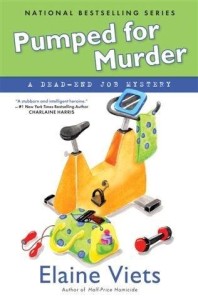 My first trailer, for “Pumped for Murder,” a Dead-End Job mystery about extreme body building, was nearly two minutes long: 1:58. http://www.elaineviets.com/new/misc/trailers.asp
My first trailer, for “Pumped for Murder,” a Dead-End Job mystery about extreme body building, was nearly two minutes long: 1:58. http://www.elaineviets.com/new/misc/trailers.asp
Kelly had to really search to find photos of women body builders, but she got some doozies.
Then mystery author James Swain told me that book trailers don’t have to be so long. He recommended short pitches to get the message across. He’s right. Here are the short trailers for “Final Sail,” set aboard a yacht: http://www.elaineviets.com/new/misc/trailers.asp
![FinalSail_approved[1] FinalSail_approved[1]](https://killzoneblog.com/wp-content/uploads/2013/09/FinalSail_approved-25255B1-25255D_thumb-25255B1-25255D-198x300.jpg)
And “Board Stiff,” a paddleboarding mystery. http://www.elaineviets.com/new/misc/trailers.asp
Thankfully, there’s no video of me taking standup paddleboard lessons.
I have a show on Radio Ear Network, so I narrated my videos. I also assembled a focus group of writers and friends to look at the rough cuts. That’s essential. Sometimes, I got so wrapped up in the video, I lost track of the story. 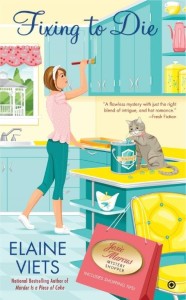
My new trailer is for “Fixing to Die,” my November Josie Marcus Mystery Shopper mystery. This short trailer was different from the Dead-End Job mysteries, which are set in anything-goes South Florida. Josie is a St. Louis single mom who’s newly married and renovating her first house. The trailer and the music needed a sitcom feel. http://www.youtube.com/watch?v=y7B8_GR0WIo&feature=youtu.be
Six months worth of work and seventy thousand words reduced to 57 seconds: That’s the art and the goal of the book trailer.
Book Production
What happens after you sell a book to a publishing house? Despite what you may think if you’re a new author, your work is far from finished. In case you haven’t had experience yet with this stage in the writing process or if you are an interested reader, let me describe it for you.
First you’ll hear back from the editor with line edits. Usually we get these as Track Changes in Microsoft Word. The editor will write comments in the margins relevant to the story and will delete/add sentences in the body of the work. You may or may not have a deadline for returning revisions, with your corrections also done in Track Changes.
Assuming your editor accepts this version, next you’ll receive the copy edits. If you’re unsure about the difference between line or story edits and copyediting, see my article here: http://bit.ly/18zyJbj. You make corrections again and send them back. Often I’ll find problems like sentences that should be bumped ahead to the next paragraph, missing punctuation or dialogue attributed to the wrong character. These are formatting errors.
Next come the page proofs or galleys. This is your last chance to make changes and to proofread your work. Again, you’ll have a deadline, often a week or two, in which to respond.
Sometime along the way, you may be lucky enough to receive an advance peek at the front cover design. Recently I got the one for my next mystery, and I immediately sent back two corrections and some color preferences. I’m lucky my publisher is so accommodating.
You may also get a glimpse at the inside cover flap (for a hardcover) and back cover copy. Once I felt the wording was too revealing about the suspects and requested changes. It’s nice when you have a chance to give your approval.
Naturally, if you are self-publishing, you have to hire people to do all these tasks. But you’ll still have the proofreading and corrections regardless of which route you take.
At the moment, I am working on four books. Three are already written. On Book 1, I’m waiting for page proofs and final cover design. This one already has a scheduled publication date. On Book 2, I am hoping for an offer followed by line edits. These will take me a while since the story is a long one. On Book 3, I’m working with an editor toward self-publishing my first original title.
As for book 4, I’m only at the synopsis and research stage, but I need to start writing it soon to finish by my editor’s requested date. Add in various trips and holidays within the next few months, and I’ll be lucky to have time to breathe. This requires prioritizing. The books that come in with edits or page proofs from my publishing houses will be first on the list.
So you see, until a book is actually on the virtual (or real) bookshelves, your work isn’t finished. When the book finally is for sale, then you’ll be jumping on the marketing bandwagon. And that starts a whole new ride.
How many of you have several works in production at the same time?


